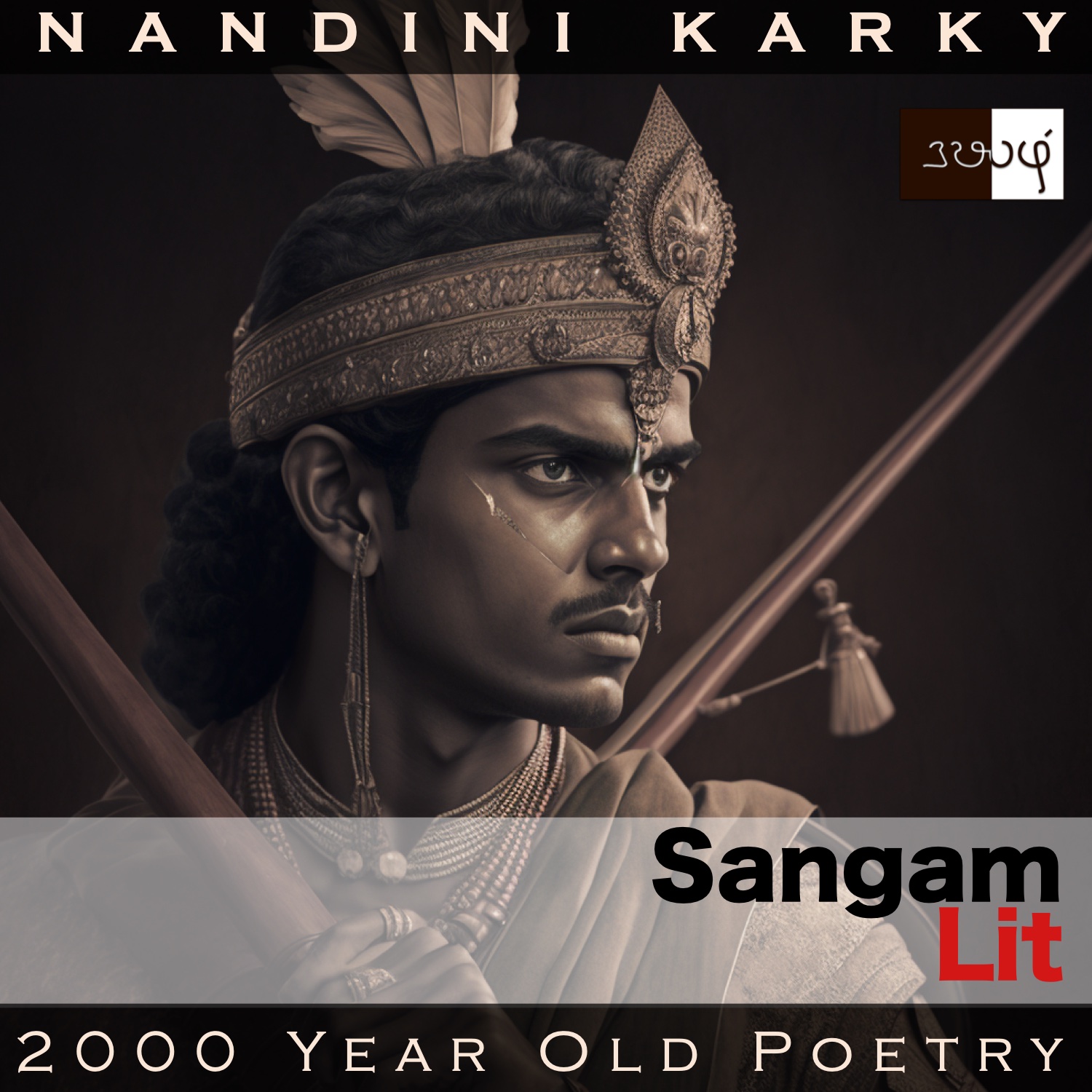Podcast: Play in new window | Download
Subscribe: Apple Podcasts | Spotify | Amazon Music | Android | iHeartRadio | TuneIn | RSS | More
In this episode, we are given strong hints about the age of a warrior king, as depicted in Sangam Literary work, Puranaanooru 77, penned about the Pandya King Thalaiyaalankaanathu Cheruvendra Nedunchezhiyan by the poet Idaikundroor Kizhaar. Set in the category of ‘Vaagai Thinai’ or ‘King’s victory’, the verse talks about the attitude of this king on the battlefield.

கிண்கிணி களைந்த கால் ஒண் கழல் தொட்டு,
குடுமி களைந்த நுதல் வேம்பின் ஒண் தளிர்
நெடுங் கொடி உழிஞைப் பவரொடு மிலைந்து,
குறுந் தொடி கழித்த கைச் சாபம் பற்றி,
நெடுந் தேர்க் கொடுஞ்சி பொலிய நின்றோன்
யார்கொல்? வாழ்க, அவன் கண்ணி! தார் பூண்டு,
தாலி களைந்தன்றும் இலனே; பால் விட்டு
அயினியும் இன்று அயின்றனனே; வயின்வயின்
உடன்று மேல் வந்த வம்ப மள்ளரை
வியந்தன்றும், இழிந்தன்றும் இலனே; அவரை
அழுந்தப் பற்றி, அகல் விசும்பு ஆர்ப்பு எழ,
கவிழ்ந்து நிலம் சேர அட்டதை
மகிழ்ந்தன்றும், மலிந்தன்றும், அதனினும் இலனே.
Now, we are in the midst of a series of songs by this poet celebrating the Pandya king Nedunchezhiyan and his unparalleled victory at the Thalaiyaalankaanum battlefield. The poet’s words can be translated as follows:
“On his feet, which have been shorn of ‘kinkini’ anklets, he wears radiant warrior anklets; Above his forehead, shorn of the tuft of hair, he wears shining neem leaves which have been woven together along with long strands of balloon vines; In his hands, from which small bangles have been removed, is a fearsome bow; He stands brightening the ornamental staff of the tall chariot. Who might he be? Long live his head garland! Even as he wears a garland around his neck, he has not removed the protective talisman necklace; And, it is but today that his staple food changed from milk to cooked rice; Seeing the many rows of furious warriors who stood to fight him, he neither treated them with awe nor with disregard; When he caught hold of them firmly, made their cries soar to the skies, and pinned them down to the ground, he was neither filled with joy nor pride because of his actions!”
Time to delve into the nuances. The poet decides to describe the appearance and accessories on different parts on this king’s form as he readies for the battle. The first thing he talks about are the feet, and he tells us what the king was wearing previously and what he’s wearing just now. Till recently, these feet were clad with a specific type of anklets called as ‘Kinkini’ anklets, the kind with a lot of bells, and now, warrior anklets adorn the same feet, the poet tells us. For now, let’s take in these details as they are, and wait to understand the significance of the same. Next, the poet talks about how the tuft of hair atop the king’s head is now gone, and in its place, are wreaths of neem leaves and balloon vines, the medicinal value of which we discussed in the previous poem. Continuing with this list of ‘what was’ and ‘what is’, we find next hands, bereft of small bangles, now holding a bow. The poet pauses the list here and wonders who could be this dashing person, brightening the chariot he rides upon, and then adds a blessing upon his head garland.
After that brief pause, the poet continues by saying although the king wears a neck garland, he has not removed a talisman-like necklace still, and as the final point, mentions how it was only recently the king moved from a diet of milk to that of cooked rice. While all these may seem bizarre to those who do not understand the significance, each one of these transitioning items is meant to convey something striking about the king’s youth. Let’s take one object after the other. First are those ‘Kinkini’ anklets. These are worn by young children to alert their parents about their whereabouts. Next, apparently it was a practice in Sangam times for young boys to have a small tuft of hair at the top of their head, something which was removed when they came of age. The reference to small bangles talks about how the king’s arms were slender like that of a child. Next, that talisman-like necklace was placed on a child’s neck by protective parents, no doubt, as part of their customs in keeping the young ones safe. Finally, the utter give-away is the detail about this person that he had just stopped drinking milk and turned to eating rice. Although this happens pretty early in the life of an infant in contemporary society, it’s possible in ancient times, the children were fed milk for a really long time. So, all this is simply to say, in what feels to me as a slightly exaggerated tone that here is a king, who is but a boy arriving at the doors of adolescence, and yet, he is entering the battlefield so radiantly.
From the youthful appearance of the king, now the poet turns to how he behaves on the battlefield. He mentions two striking aspects: One, when this king sees rows and rows of enemy soldiers, neither does he overestimate them and look at them with shock and awe nor does he look down upon them as insignificant. Two, when he attacks them and makes them submit with their cries soaring so high, at that moment, there is no excessive happiness or pride that he has been able to achieve such an unimaginable feat. That is a mark of someone wise enough to be humble about one’s accomplishments! And thus, the poet not only highlights how young the king is, but also how mature and calm in his handling of the challenges on the battlefield. A perfect character sketch of a striking king in Sangam history!




Share your thoughts...